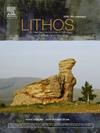地幔中矿物质间镍同位素平衡分馏的第一原理计算
IF 2.9
2区 地球科学
Q2 GEOCHEMISTRY & GEOPHYSICS
引用次数: 0
摘要
人们越来越多地利用镍(Ni)同位素系统学来了解行星的分化过程。然而,由于缺乏地幔矿物间镍同位素平衡分馏的基础知识,阻碍了镍同位素在这一领域的进一步应用。在这项研究中,我们进行了第一原理计算,以确定主要掺镍地幔矿物(包括橄榄石、正长石、挛辉石、辉石和尖晶石)中 60Ni/58Ni (103lnβ60-58)的还原分区函数比。我们的计算显示,在本文研究的矿物掺镍浓度范围内,103lnβ60-58对镍浓度不敏感,103lnβ60-58依次为辉石、挛辉石、正长石、橄榄石和尖晶石。此外,103lnβ60-58 与镍的平均作用力常数(< F >)主要呈线性关系,这种关系主要受 NiO 键平均长度的影响。通过比较地幔岩石中测得的矿物间 Ni 同位素差异与我们的预测结果,我们发现橄榄石、尖晶石和正辉石在大多数橄榄岩样品中达到了 Ni 同位素平衡。相反,霞石似乎与其他矿物相失去了平衡,这很可能是由于霞石的成因。此外,结合理论计算和实验室实验得出的熔体-岩浆 Ni 同位素分馏系数,我们证明地幔硅酸盐熔融产生的熔体与来源相比具有更重的 Ni 同位素特征。因此,在全球玄武岩中观察到的系统性较轻的镍同位素组成不能纯粹归因于硅酸盐熔融引起的镍同位素分馏。还必须考虑到另外一个过程,也许是硫化物溶解。本文章由计算机程序翻译,如有差异,请以英文原文为准。
First-principles calculations of equilibrium inter-mineral nickel isotope fractionation in the mantle
The nickel (Ni) isotopic systematics has been increasingly utilized to understand the processes governing planetary differentiation. However, there is a lack of fundamental knowledge regarding equilibrium Ni isotope fractionation among mantle minerals, which hampered further applications of Ni isotopes in this domain. In this study, we conducted first-principles calculations to determine the reduced partition function ratios of 60Ni/58Ni (103lnβ60–58) in major Ni-doped mantle minerals, including olivine, orthopyroxene, clinopyroxene, pyrope and spinel. Our calculations reveal that the 103lnβ60–58 is insensitive to the Ni concentration within the mineral Ni concentration ranges investigated here, and the 103lnβ60–58 increases in the order of pyrope < clinopyroxene < orthopyroxene < olivine < spinel. Moreover, the 103lnβ60–58 demonstrates a predominantly linear relationship with the average force constant (< F >) of Ni that is mainly influenced by the average Ni![]() O bond length. By comparing the measured inter-mineral Ni isotopic differences in mantle rocks with our predicted results, we find that olivine, spinel and orthopyroxene in most peridotitic samples have attained Ni isotopic equilibrium. Conversely, clinopyroxene appears to fall out of equilibrium with other mineral phases, likely attributed to its metasomatic origin. Furthermore, in conjunction with the melt-olivine Ni isotope fractionation factor obtained from theoretical calculation and laboratory experiment, we demonstrate that mantle silicate melting produces melts with a heavier Ni isotopic signature compared to the source. Consequently, the systematically lighter Ni isotopic compositions observed in global basalts cannot be purely attributed to silicate melting-induced Ni isotope fractionation. An additional process, perhaps sulfide dissolution, must be invoked.
O bond length. By comparing the measured inter-mineral Ni isotopic differences in mantle rocks with our predicted results, we find that olivine, spinel and orthopyroxene in most peridotitic samples have attained Ni isotopic equilibrium. Conversely, clinopyroxene appears to fall out of equilibrium with other mineral phases, likely attributed to its metasomatic origin. Furthermore, in conjunction with the melt-olivine Ni isotope fractionation factor obtained from theoretical calculation and laboratory experiment, we demonstrate that mantle silicate melting produces melts with a heavier Ni isotopic signature compared to the source. Consequently, the systematically lighter Ni isotopic compositions observed in global basalts cannot be purely attributed to silicate melting-induced Ni isotope fractionation. An additional process, perhaps sulfide dissolution, must be invoked.
求助全文
通过发布文献求助,成功后即可免费获取论文全文。
去求助
来源期刊

Lithos
地学-地球化学与地球物理
CiteScore
6.80
自引率
11.40%
发文量
286
审稿时长
3.5 months
期刊介绍:
Lithos publishes original research papers on the petrology, geochemistry and petrogenesis of igneous and metamorphic rocks. Papers on mineralogy/mineral physics related to petrology and petrogenetic problems are also welcomed.
 求助内容:
求助内容: 应助结果提醒方式:
应助结果提醒方式:


